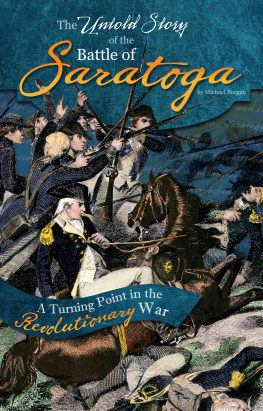MAJOR BATTLES AND CAMPAIGNS
John S. D. Eisenhower, General Editor
1. The Defeat of Imperial Germany, 19171918
by Rod Paschall
2. World War II in the Mediterranean, 19421945
by Carlo DEste
3. Battles of the Revolutionary War, 17751781
by W. J. Wood
MAJOR BATTLES AND CAMPAIGNS
BATTLES OF THE REVOLUTIONARY WAR

17751781
by W. J. Wood
Lieutenant Colonel,
United States Army (Ret.)

With an Introduction by
John S. D. Eisenhower
ALGONQUIN BOOKS OF CHAPEL HILL
For Barbara
CONTENTS
LIST OF ILLUSTRATIONS
Between
Between
LIST OF MAPS AND DIAGRAMS
INTRODUCTION
by John S. D. Eisenhower
AMERICANS GENERALLY REGARD George Washington and Abraham Lincoln as the two giants of our history. And yet the degree of understanding we have accorded the two men is vastly one-sided. Lincoln we feel we know. We pace the second floor of the White House with him as, back in 1862, he anguishes over the fate of the Army of the Potomac or contemplates one of his all-too-frequent changes in the command of that army. We sit with him in Fords Theater as John Wilkes Booth sneaks up behind him. But not so George Washington. The Father of Our Country is revered by nearly all of us, but primarily because we have been told that he should be revered. The real, living Washington, with his ups and downs, his strengths and weaknesses, has been buried in myth.
So it is with the two great wars during which each of these statesmen led our fortunes. The Civil War, like Lincoln, is vivid in our memory, kept constantly alive by hundreds of new book titles every year, by reenactments of battles at our great national parks, even by automobile license plates carrying the ever-defiant Confederate battle flag. The American Revolution, on the other hand, is largely forgotten. The redcoats are no longer pictured as the brutal enemies they once were in the American imagination. The period from 1775 through 1781 was fraught with confusion, upheaval, uncertainty, and incredible danger to Patriot leaders and citizens alike. But it has been lost in our consciousness.
The reasons for our so abandoning the Revolution are obvious: the passage of time, the paucity of reliable records, general indifference to our national heritage, and the timing of the invention of the photograph, which came upon the scene some fifty years after the Revolution. The reasons, actually, are not important; the fact of our neglect, at least to the historically minded, is important indeed.
In this book, Major Battles and Campaigns: Battles of the Revolutionary War, Col. W.J. Wood is making a contribution toward rectifying our ignorance of and indifference to the American Revolution. It is a worthy endeavor, and in approaching it Colonel Wood has been conscious that he is battling obstacles. Two of these are the mythology that has grown up around our Revolution and the very complicated nature of the war itself. Let me address the second problem first.
The serious reader, trying to make some sense out of the strategic course of the Revolution, is baffled by an appalling lack of pattern. A study of the war involves a plethora of battles, some large and some small, fought at great distances from each other, encompassing various sections of the United States and Canada. Usually one campaign would hold center stage at a time, governed by the objectives of the British high command, who always retained the strategic initiative. Those objectives are not always clear to the reader. It is sometimes difficult to analyze why high-ranking British officials decided to occupy one portion or another of the United States at a given time. Why, for example, did Sir William Howe ignore the wishes of his superiors that he join Sir John Burgoyne at Albany in 1777, a move that would have altered the course of the war? The author goes into such problems with zest, and he succeeds in unraveling them with considerable success.
When it comes to the study of various individual Revolutionary battles, we find a lack of uniformity in quality, methods of operation, and competence of commanders among the armies. A British force, for example, might contain a leaven of British regulars but include as well some regiments of Hessian mercenaries, Canadian militia, and Indiansthough usually not all four groups at once. An American force would vary even more because of the vast chasm in military proficiency between raw, untrained militia and the relatively well-trained Continentals. An American force might contain both these elements, although some of the most famous American successes such as Bunker Hill and Kings Mountain were fought by militia alone. Like the British, the Americans also recruited Indians as auxiliaries, though not nearly to the same extent.
The sheer number of battles fought in this erratically-conducted war makes it impossible for the author to cover every one in a single book. Colonel Wood has overcome this difficulty by abandoning at the outset any effort to follow the Revolution through as a strategic continuum. Rather, he selects certain battles to describe, purposefully omitting others. His criteria for selection includes the drama of a particular engagement, its ability to illustrate a certain military principle, and its uniqueness. None of the battles described herein exactly, or even closely, resembles any of the others. The author does, however, strive to give some continuity, some tie-in, by skillful cross-reference. He compares British tactics at Brandywine in September 1777, to those employed a year earlier on Long Island, to mention only one instance. He has successfully striven to create an overall picture by emphasizing the highlights.
As to the mythology surrounding this poorly reported war, Colonel Wood takes much of it head-on in his very thorough and educational Authors Introduction. In that indispensable section, he clearly describes the various types of soldier who fought on either side, what each had to contend with, the equipment each carried, the nature of the weapons each employed, and the tactics by which each unit attempted to derive the greatest combat effectiveness from the weapons it carried. Vital to an understanding of those tactics, of course, is an understanding of the organizations in which the troops of both sides fought.
That indispensable Authors Introduction will also give the reader an astonishing picture of the British regular, the once-maligned redcoat. That unfortunate creature was not always a soldier by choice. Sometimes he had signed up in the British army as a fugitive from some unbearable place in British society, but too often he was a victim of the indiscriminate press gangs. He was conscripted (theoretically) for life, and his lot afforded little by way of lifes amenities. The British Tommy fought and marched for great distances in the unfamiliar American heat, stifled by uniforms fit only for the parade ground, a condition which the author describes masterfully. His picture calls forth our respect for the remarkable British soldier.
Besides the mythology surrounding our accepted view of the participating soldiers, Colonel Wood punctures other false concepts. One is the supposed superiority of the rifle over the musket under all conditions. He invites protest from super-patriots when he points out that only half of the American troops at Bunker Hill got into the fray; many of the non-participants were sheer skulkers. And finally he reminds us, in his chapter on Quebec, that the colonists were engaged in a full-scale war, even offensive operations, months before the Declaration of Independence.
Next page









